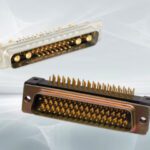VITA Specifications: Setting the Standard
The VITA specifications enable the embedded computer industry to support military, avionic, space, instrumentation, semiconductor processing, medical imaging, and industrial control applications.
The way industry standards are often viewed by the engineering community has been the source of jokes for many years:
How many engineers does it take to change a light bulb? None, they simply redefine darkness as the industry standard.
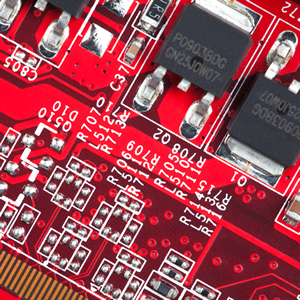 Standards serve a critical need in our world and in many ways have enabled the galaxy of electronic devices we enjoy today. Consider the challenge posed if the plug on each home appliance was different or the voltage and frequency of electricity differed in every city.
Standards serve a critical need in our world and in many ways have enabled the galaxy of electronic devices we enjoy today. Consider the challenge posed if the plug on each home appliance was different or the voltage and frequency of electricity differed in every city.
Certainly there is no lack of standards within the electronics industry. Standards have been created at every level of device, packaging, and system in nearly every segment of the market. Standards that define the physical architecture of systems may specify critical mechanical and electrical characteristics of a card cage and connectors, which can extend to the packaging of the entire product. Some define signaling protocols or minimum system performance levels, while others establish limits on unwanted radiation that can cause other systems to fail. Military standards may require documentation back to the source of all base materials used by multiple sources to ensure consistency of the end product in extremely harsh environments.
Standards-Writing Groups
Industry standards have been generated by a variety of organizations including formal standards-writing groups such as IPC, IEEE, and SAE. In some cases, a de facto standard is created by the market that chooses it over all competitors. The VHS cassette videotape format won over the Betamax format after several years of battling for the consumer market. More recently, independent groups that share a common interest, such as industry alliances (Ethernet Alliance), special interest groups (Small Form Factor SIG), multi-source agreements (CFP MSA), and trade associations (VITA), have banded together to advance their causes. Their objective is to promote a specific product or protocol by creating a framework that simplifies the adoption of the standard as well as a process to ensure compatibility among qualified products.
Industry standards can be formed around a particular industry segment, or span many markets. In other cases, they can address a highly specific application. Input/output interfaces have been a particularly rich segment where many standards have been established. This makes sense as promoters want to ensure interoperability among the products of many manufacturers. Standardized interfaces such as USB, HDMI, RS232, and modular phone plugs are broad-based industry standards and are found in a host of consumer electronic products.
Internal device standards are equally important. Backplane connector standards such as VMEbus and Compact PCI not only define the physical connector, but also include specific pin assignments that allow daughtercards from multiple competitive suppliers to plug into a common backplane.
Manufacturers and Standards
Manufacturers have often had a love/hate relationship with standards. Innovative companies have been understandably reluctant to share their costly intellectual property and encourage competitors to enter their markets, which often results in lower prices and reduced market share. At the same time, a larger market may develop increasing potential revenue for all participants over a much longer period of time. OEMs love the competition and lower prices, but may have concerns about total compatibility. Hardware and software that are defined by a standard are often supported with reference designs that ensure a minimum level of performance. Standardized products are easier to implement, reducing the design cycle time as well as new product design risk. In select component markets where a standard currently does not exist, suppliers may be forced by large OEMs to establish a second-source relationship with a competitor to ensure mechanically and electrically identical products at competitive prices.
 VITA (VMEbus International Trade Association) is an example of a highly focused trade organization that creates industry standards commonly used in the embedded computer industry. Equipment in this segment typically requires exceptional reliability with long product life cycles in harsh environments, which make devices built to stringent specifications an absolute requirement.
VITA (VMEbus International Trade Association) is an example of a highly focused trade organization that creates industry standards commonly used in the embedded computer industry. Equipment in this segment typically requires exceptional reliability with long product life cycles in harsh environments, which make devices built to stringent specifications an absolute requirement.
With its charter of creating open standards and open markets, VITA has put emphasis on ensuring that its standards are developed in a highly transparent process that minimizes political influences and time to publication.
VITA Standards Organization
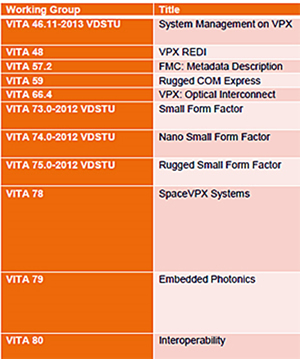 The VITA Standards Organization (VSO) is the standards development arm of VITA and consists of a subset of VITA members who have an interest in participating in a specific working group. Working groups are formed when three or more members offer to sponsor a proposal for a new working group.
The VITA Standards Organization (VSO) is the standards development arm of VITA and consists of a subset of VITA members who have an interest in participating in a specific working group. Working groups are formed when three or more members offer to sponsor a proposal for a new working group.
The charter of a VITA working group is a little different than most other standards-writing organizations in that it has full authority to develop a new standard, with no individual member having the ability to kill a project. If a conflict develops within a working group, a technical committee of the VSO can step in and resolve the issue. This structure tends to reduce the influence of politics that some participants may use to their advantage. The number of working groups varies, but 33 groups are now actively developing or refining VITA standards.
VITA’s Ex-Ante Policy
Another difference is the adoption of an ex-ante policy within VITA. In order to ensure that a component defined by a VITA standard is not restricted by an undisclosed patent, a process of early disclosure was established. VITA insists that manufacturers of any component proposed for inclusion in a draft standard reveal the existence of all essential patents and applications and agree to offer a license at terms that are fair, reasonable, and non-discriminatory (FRAND). With this policy in place, no supplier is able to manipulate access of critical IP to second-source manufacturers and ensures the open source commitment of VITA standards.
The implementation of the VITA ex-ante policy was highly controversial due to concerns about potential anti-trust issues, which led to a temporary loss of accreditation by ANSI. Full accreditation was restored after several decisions by the Justice Department, which found it to be pro-competitive.
Once a new standard is approved by the working group, the VITA technical director prepares a petition to the American National Standards Institute (ANSI) to begin the public review process. After resolution of any issues that are identified, ANSI certifies the standard which is then published by VITA.
Since its founding in 1982, VITA has developed an impressive series of standards that have enabled the embedded computer industry to support military, avionic, space, instrumentation, semiconductor processing, medical imaging, and industrial control applications. The VITA family of specifications includes technologies at the core, interconnects/fabrics, mezzanines/modules, support/packaging, and systems levels.
VITA Today
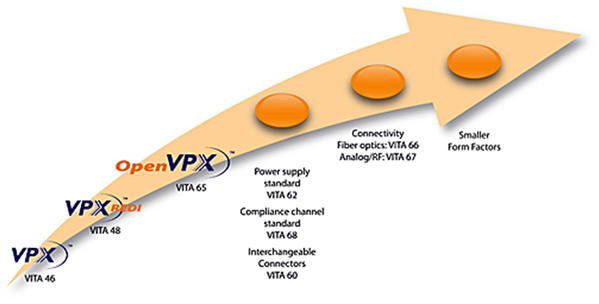
In order to stay technologically current and relevant to the industries it serves, VITA continues to expand its portfolio of standards and stay on top of constantly evolving technology.
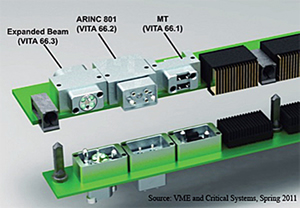 In the past, most VITA standards have focused on copper interconnects, but the group has started to define a series of optical alternatives that will enable future high-performance/high-reliability systems. The VITA 66.4 optical backplane standard is the first implementation of a fiber backplane interconnect, adding up to 24 optical fiber interconnects to the standard VPX backplane, setting the stage for next-generation products in military applications.
In the past, most VITA standards have focused on copper interconnects, but the group has started to define a series of optical alternatives that will enable future high-performance/high-reliability systems. The VITA 66.4 optical backplane standard is the first implementation of a fiber backplane interconnect, adding up to 24 optical fiber interconnects to the standard VPX backplane, setting the stage for next-generation products in military applications.
As technology continues to evolve and new applications for embedded computers expand in robotic devices, autonomous vehicles, and the Internet of things, standards created by VITA will enable products that ensure performance, compatibility, and reduced time to market.
Robert Hult, Market Director, Bishop & Associates, Inc.
- Digital Lighting Enhances your Theatrical Experience - March 5, 2024
- DesignCon 2024 in Review - February 13, 2024
- Chip Technology Struggles to Keep Pace with Moore’s Law - January 30, 2024


